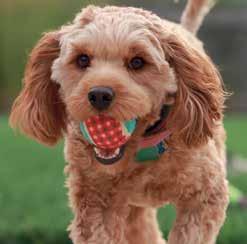
3 minute read
Pets Corner
from SE23 February 2021
by SE Magazines
How To Behave In Public Spaces
Pets Corner with Leonie St Clair | www.londondogstraining.co.uk
Iwould be the first to defend those that wish to own dogs and would never want to see dogs banned from public spaces. However, unless a large numbers of dog owners change their ways, we may see dogs banned from parks in future or control orders issued that require dogs to be kept on a lead in any public space- and what a shame that would be. The current explosion in dog ownership means parks are stuffed with young dogs and levels of control leave much to be desired.
In earlier articles I have addressed confusion over socialisation which does not mean lack of supervision. Nor is not about letting young dogs playfight and bombard other dogs and humans at will. That is not true socialisation and it is certainly not appropriate exercise or training. Socialisation is a developmental process where your pup learns about his environment and what is the norm.
Teaching boundaries is a valuable part of that 3) Attend training early on. There are oodles of process. online training courses on offer. The beauty of Allowing your pup to jump on other dogs, lockdown is that it matters not where the class children and humans may help to create an antisocial and frustrated adult. Jumping up, mobbing and stealing may be naturally self-rewarding behaviours but we do not want to perpetuate them. Early positive training and control will soon is held. Online training is great because in the quiet of your home it is easier for you and your pup to learn. Go to www.abtc.org.uk for qualified dog trainers around the UK (look under the Animal Training Instructor section). teach your pup more socially acceptable and 4) Use a long line. This way your pup can enjoy equally rewarding behaviours. Here is a checklist degrees of freedom. Pups do need interaction with to promote better dog ownership in public spaces. other dogs but recall them frequently and move 1) The park is for all and not everyone likes your dog or puppy. Never allow your pup to just wander up to people. Teach your pup that interaction with humans and other dogs is by invitation and under your direction. Make it fun. Help them to learn that on; reward compliance handsomely. Look for suitable off-lead contexts and limit duration. Teach your pups to approach adult dogs and all humans calmly and with respect. Again, focus on getting a bombproof recall. It is for you to decide who your dog interacts with, not them.them sticking with you gets a reward (your praise, a treat, a game). 5) Don’t stand around chatting while your pooches frolic together in the park- you are setting them 2) Do not let your dog mob or rush at other humans up to become canine hooligans. Consider your or strange dogs. This especially applies to owners dog’s needs (a big clue will be in what your dog of teenage hounds. Running at another being is was originally developed to do). Start to train plain rude and your youngster may find itself on and develop games and activities around your the receiving end of a severe canine drubbing or dog’s innate skills (scenting, tracking, retrieving, an angry human. This is not a great way to teach distance running). Make ‘you’ the centre of your your pup boundaries. All dogs should earn their dog’s world, not other dogs. Older dogs can learn freedom by having good recall, self-control and to jog with their owners. Most enjoy the sense of manners. being on a ‘mission’.








